
If you suffer from the following symptoms of GERD repeatedly, don’t shrug it off as simply another bout of
heartburn or another common digestive condition. Individuals with GERD experience these symptoms at least twice a week, so much so that they interfere or debilitate their daily life (i.e., work, school, social functions, parenting, etc.).
1. Heartburn
Heartburn is caused by acid indigestion, or that familiar burning pain that begins in your stomach and rises to mid-abdomen, sitting uncomfortably in your chest and often situates itself as an uncomfortable, invisible lump in your throat.
2. Dyspepsia
Common to those who suffer from acid reflux disease, dyspepsia really means “stomach discomfort” and occurs with that nauseated feeling post-meal, bloating, abdominal discomfort, and of course, burping.
3. Regurgitation
Another prominent symptom of acid reflux, regurgitation occurs when stomach acid backs up into your throat and sometimes into your mouth, producing a sour aftertaste, “wet burp”, or vomit if stomach contents actually make a reappearance.
4. Chest pain and discomfort
A scary symptom of GERD is chest pain, which can often be mistaken for a heart attack. This discomfort typically manifests itself in the upper abdominals or chest and leads to shortness of breath and even difficulty swallowing.
Most symptoms of simple heartburn can be treated with over-the-counter medications, and dietary and lifestyle changes. However, those with GERD may require prescription medications, doctor’s advice, and maybe even surgery to cope with this uncomfortable condition.



